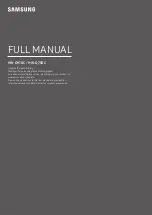
1 Safety Precautions
1.1. GENERAL GUIDELINES
1. When servicing, observe the original lead dress. If a short circuit is found, replace all parts which have been overheated or
damaged by the short circuit.
2. After servicing, see to it that all the protective devices such as insulation barriers, insulation papers shields are properly
installed.
3. After servicing, carry out the following leakage current checks to prevent the customer from being exposed to shock hazards.
1.1.1.
LEAKAGE CURRENT COLD CHECK
1. Unplug the AC cord and connect a jumper between the two prongs on the plug.
2. Measure the resistance value, with an ohmmeter, between the jumpered AC plug and each exposed metallic cabinet part on
the equipment such as screwheads, connectors, control shafts, etc. When the exposed metallic part has a return path to the
chassis, the reading should be between 1M
Ω
and 5.2M
Ω
.
When the exposed metal does not have a return path to the chassis, the reading must be
.
Figure 1
1.1.2.
LEAKAGE CURRENT HOT CHECK (See Figure 1.)
1. Plug the AC cord directly into the AC outlet. Do not use an isolation transformer for this check.
2. Connect a 1.5k
Ω
, 10 watts resistor, in parallel with a 0.15µF capacitors, between each exposed metallic part on the set and a
good earth ground such as a water pipe, as shown in Figure 1.
3. Use an AC voltmeter, with 1000 ohms/volt or more sensitivity, to measure the potential across the resistor.
4. Check each exposed metallic part, and measure the voltage at each point.
5. Reverse the AC plug in the AC outlet and repeat each of the above measurements.
6. The potential at any point should not exceed 0.75 volts RMS. A leakage current tester (Simpson Model 229 or equivalent) may
be used to make the hot checks, leakage current must not exceed 1/2 milliamp. In case a measurement is outside of the limits
specified, there is a possibility of a shock hazard, and the equipment should be repaired and rechecked before it is returned to
the customer.
1.2. Before Repair and Adjustment
Disconnect AC power, discharge Power Supply Capacitors C5716, C5717, C5718 through a 10
Ω
, 10 W resistor to ground.
DO NOT SHORT-CIRCUIT DIRECTLY (with a screwdriver blade, for instance), as this may destroy solid state devices.
After repairs are completed, restore power gradually using a variac, to avoid overcurrent.
Current consumption at AC 230 V, 50 Hz in NO SIGNAL mode volume minimal should be ~ 800 mA.
1.3. Protection Circuitry
The protection circuitry may have operated if either of the following conditions are noticed:
·
No sound is heard when the power is turned on.
·
Sound stops during a performance.
The function of this circuitry is to prevent circuitry damage if, for example, the positive and negative speaker connection wires are
“shorted”, or if speaker systems with an impedance less than the indicated rated impedance of the amplifier are used.
If this occurs, follow the procedure outlines below:
5
SA-HT540E / SA-HT540EB / SA-HT540EG
Summary of Contents for SA-HT540E
Page 8: ...5 Caution for AC Cord 8 SA HT540E SA HT540EB SA HT540EG ...
Page 10: ...10 SA HT540E SA HT540EB SA HT540EG ...
Page 12: ...8 Operation Procedures 8 1 Remote Control Keys Operation 12 SA HT540E SA HT540EB SA HT540EG ...
Page 20: ...20 SA HT540E SA HT540EB SA HT540EG ...
Page 48: ...48 SA HT540E SA HT540EB SA HT540EG ...
Page 50: ...SA HT540E SA HT540EB SA HT540EG 50 ...
Page 58: ...SA HT540E SA HT540EB SA HT540EG 58 ...
Page 60: ...60 SA HT540E SA HT540EB SA HT540EG ...
Page 76: ...SA HT540E SA HT540EB SA HT540EG 76 ...
Page 89: ...23 Exploded Views 23 1 Cabinet Parts Location 89 SA HT540E SA HT540EB SA HT540EG ...
Page 90: ...90 SA HT540E SA HT540EB SA HT540EG ...
Page 91: ...23 2 Packaging 91 SA HT540E SA HT540EB SA HT540EG ...






































